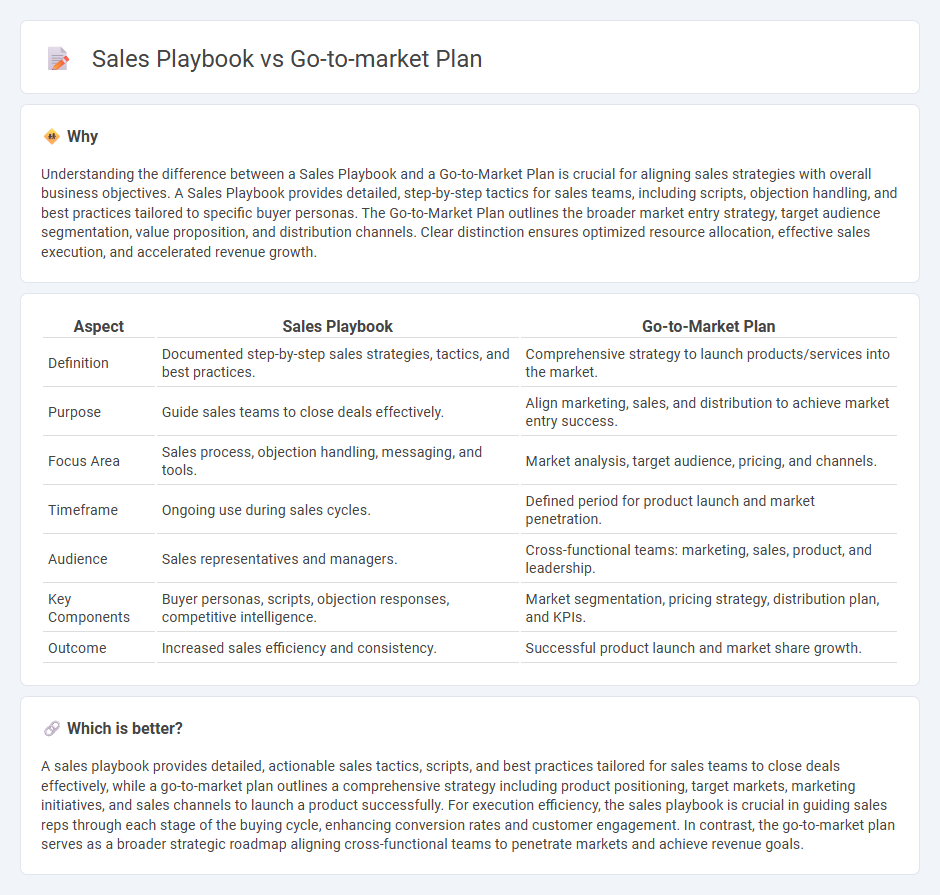
A Sales Playbook offers detailed scripts, tactics, and best practices tailored for sales teams to engage customers and close deals efficiently. A Go-to-Market Plan outlines strategic market entry, including target audiences, positioning, and distribution channels to maximize business impact. Explore the key differences and how each drives revenue growth in your organization.
Why it is important
Understanding the difference between a Sales Playbook and a Go-to-Market Plan is crucial for aligning sales strategies with overall business objectives. A Sales Playbook provides detailed, step-by-step tactics for sales teams, including scripts, objection handling, and best practices tailored to specific buyer personas. The Go-to-Market Plan outlines the broader market entry strategy, target audience segmentation, value proposition, and distribution channels. Clear distinction ensures optimized resource allocation, effective sales execution, and accelerated revenue growth.
Comparison Table
| Aspect | Sales Playbook | Go-to-Market Plan |
|---|---|---|
| Definition | Documented step-by-step sales strategies, tactics, and best practices. | Comprehensive strategy to launch products/services into the market. |
| Purpose | Guide sales teams to close deals effectively. | Align marketing, sales, and distribution to achieve market entry success. |
| Focus Area | Sales process, objection handling, messaging, and tools. | Market analysis, target audience, pricing, and channels. |
| Timeframe | Ongoing use during sales cycles. | Defined period for product launch and market penetration. |
| Audience | Sales representatives and managers. | Cross-functional teams: marketing, sales, product, and leadership. |
| Key Components | Buyer personas, scripts, objection responses, competitive intelligence. | Market segmentation, pricing strategy, distribution plan, and KPIs. |
| Outcome | Increased sales efficiency and consistency. | Successful product launch and market share growth. |
Which is better?
A sales playbook provides detailed, actionable sales tactics, scripts, and best practices tailored for sales teams to close deals effectively, while a go-to-market plan outlines a comprehensive strategy including product positioning, target markets, marketing initiatives, and sales channels to launch a product successfully. For execution efficiency, the sales playbook is crucial in guiding sales reps through each stage of the buying cycle, enhancing conversion rates and customer engagement. In contrast, the go-to-market plan serves as a broader strategic roadmap aligning cross-functional teams to penetrate markets and achieve revenue goals.
Connection
A Sales playbook and Go-to-market plan are interconnected by providing a structured framework for sales strategies and tactics aligned with market entry objectives. The Sales playbook outlines detailed processes, messaging, and best practices for sales teams to follow, while the Go-to-market plan defines target markets, customer segments, and competitive positioning. Together, they ensure consistent execution and maximize revenue generation through coordinated market engagement and sales efforts.
Key Terms
**Go-to-market plan:**
A Go-to-market plan outlines the comprehensive strategy for launching a product or service, targeting market segments, defining value propositions, and aligning marketing, sales, and distribution channels. It integrates market research, competitive analysis, pricing strategies, and customer acquisition tactics to maximize market penetration and revenue growth. Explore how a robust Go-to-market plan can drive business success and accelerate product adoption.
Target Market
A Go-to-Market (GTM) plan defines the overall strategy for reaching the target market, including market segmentation, positioning, and channel selection. The Sales Playbook focuses on tactical execution within the target market, detailing sales messaging, objection handling, and competitive positioning specific to customer personas. Explore how aligning these tools enhances market penetration and sales effectiveness.
Value Proposition
A go-to-market plan defines the strategic roadmap for introducing a product to the market, emphasizing the articulation of the unique value proposition tailored to target customer segments. Sales playbooks provide detailed, actionable steps and messaging frameworks that help sales teams consistently communicate the value proposition during customer interactions. Explore how aligning both frameworks around a clear value proposition can accelerate sales effectiveness and market penetration.
Source and External Links
How to create a go-to-market strategy (template & examples) - Asana - A go-to-market (GTM) strategy is a step-by-step plan for launching a new product or expanding an existing product into a new market by defining the product, ideal customer, market, and approach to reach customers effectively.
What is a Go-to-Market Strategy? | Complete GTM Guide - A GTM strategy is a comprehensive plan outlining how a product will be positioned, priced, promoted, and distributed to a target audience, combining multiple business functions to ensure market fit and efficient product adoption.
Go-to-market strategy - Wikipedia - A go-to-market strategy is a plan that uses external resources like sales forces and distributors to deliver a unique value proposition, involving target market definition, value proposition finalization, pricing strategy, distribution choice, and promotion planning.
 dowidth.com
dowidth.com